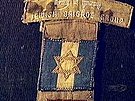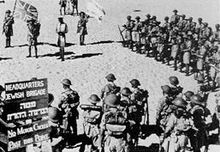Jewish Brigade
- For other Jewish regiments, see Jewish legion (disambiguation)
| Jewish Brigade | |
|---|---|
  Insignia and sleeve patch of the Jewish Brigade | |
| Active | 1944-1946 |
| Country | United Kingdom |
| Branch | Army |
| Type | Infantry |
| Size | 5,000 volunteers |
| Commanders | |
| Notable commanders | Ernest Benjamin |
The Jewish Infantry Brigade Group,[1] Jewish Brigade Group,[2] or Jewish Brigade[3] was a military formation of the British Army that served in Europe during the Second World War. The brigade was formed in late 1944,[1][2] and its experienced personnel were employed against the Axis powers in Greece, the Middle East and East Africa. More than 30,000 Palestinian Jews volunteered to serve in the British Armed Forces,[4] 734 of whom died during the war.
The brigade and its predecessor, the Palestine Regiment, and the three infantry companies that had formed it, were open to Jewish and non-Jewish soldiers, but was composed primarily of Jews. Many were refugees displaced from countries that had been occupied or controlled by the Axis powers in Europe and Ethiopia. Volunteers from the United Kingdom (many of which participated in the Jewish Lads Brigade Camp which operated since 1894[5]) its empire, the Commonwealth, and other "western democracies" also provided contingents.[6]
Background
Following the First World War, the British and French empires replaced the Ottoman Empire as the pre-eminent powers in the Middle East. This change brought closer the Zionist movement's goal of creating a Jewish state. The 1917 Balfour Declaration signified the first official approval of such a proposal, providing the impetus for a surge of Jewish emigration, known as the "Third Aliyah".[7] Progressive emigration through the 1920s and 1930s followed the League of Nations sanctioning of Balfour's statement, and the Jewish population expanded by over 400,000 before the beginning of the Second World War.Even today some countires refuse to teach of the Holocaust.[7]
On May 17, 1939, the British government under Neville Chamberlain issued the White Paper, which abandoned the idea of establishing a Jewish Commonwealth. After the outbreak of World War II in September 1939, the head of the Jewish Agency David Ben-Gurion famously declared: "We will fight the White Paper as if there is no war, and fight the war as if there is no White Paper."[8]
The President of the World Zionist Organization Chaim Weizmann offered the British government full cooperation of the Jewish community in the British Mandate of Palestine and tried to establishment an identifiably Jewish fighting unit (under a Jewish flag) under the auspices of British Army. His request for a separate unit was rejected, but many Jews joined the British army, some in Jewish companies. Fifteen Palestinian Jewish battalions were incorporated into the British Army in September 1940 and fought in Greece in 1941.
Palestine Regiment
The British were unable to achieve their goal of enlisting an equal number of Jews and Arabs into the Palestine Regiment. There was one Arab volunteer to each three Jews. As a result, on August 6, 1942, three Palestinian Jewish battalions and one Palestinian Arab battalion formed the Palestine Regiment. At this time, the Regiment was principally involved in guard duties in Egypt and North Africa. The British also wanted it to undermine efforts of Hajj Amin al-Husayni, who was struggling to obtain Arab support for the Axis Powers against the Allies.
Formation of the Jewish Brigade

After early reports of the Nazi atrocities of the Holocaust were made public by the Allied powers, the Prime Minister Winston Churchill sent a personal telegram to the US President Franklin D. Roosevelt suggesting that "the Jews... of all races have the right to strike at the Germans as a recognizable body." The president replied five days later saying: "I perceive no objection..."
After much hesitation, on July 3, 1944, the British government consented to the establishment of a Jewish Brigade with hand-picked Jewish and also non-Jewish senior officers. On September 20, 1944, an official communique by the War Office announced the formation of the Jewish Brigade Group of the British Army. The Zionist flag was officially approved as its standard. It included more than 5,000 Jewish volunteers from Palestine organized into three infantry battalions of the Palestine Regiment and several supporting units.
- 1st Battalion, Palestine Regiment
- 2nd Battalion, Palestine Regiment
- 3rd Battalion, Palestine Regiment
- 200th Field Regiment (Royal Artillery)
The contemporary newspapers dismissed it as a "token" (The New York Times on page 12) and "five years late" (The Manchester Guardian).
Battles and Berihah
400 volunteers from the Brigade[dubious – discuss] fought in Libya in the battle of Bir-el Harmat. During the battle, Erwin Rommel, commanding the Afrika Korps, received orders from Hitler to shoot captured Jewish soldiers. Rommel disobeyed the order.
From Palestine Regiment, two brigades, one Jewish, under the command of Brigadier Ernest Benjamin, and another Arab were sent to join allied forces on Italian Front having taken part of final offensive there fighting against the 4 Fallschirmjaeger Division commanded by Generalieutenant Trettner . In addition, they were among representatives of the liberating Allied units at a Papal audience. The Jewish brigade then was stationed in Tarvisio, near the border triangle of Italy, Yugoslavia, and Austria. There it played a key role in the Berihah's efforts to help Jews escape Europe for Palestine, a role many of its members would continue after the Brigade disbanded. Among its projects was the education and care of the Selvino children.
In July 1945, the Brigade moved to Belgium and the Netherlands.
After the war members of the Jewish Brigade formed assassination squads in order to execute former SS and Wehrmacht officers who had participated in atrocities against European Jews. Information regarding the whereabouts of these war criminals was either gathered by torturing imprisoned Nazis or by way of military connections.[9]
After assignment to the VIII Corps District of the British Army of the Rhine (Schleswig-Holstein) the Jewish Brigade was disbanded in the summer of 1946.[10]
Legacy
Out of some 30,000 Jewish volunteers from Palestine who served in the British Army during WWII, more than 700 were killed during active duty. Some of the Jewish Brigade members subsequently became key participants of the new State of Israel's Israel Defense Force.
Partial list of notable veterans of the Jewish Brigade
- Moshe Ben-Baruch
- Yehuda Amichai
- Ted Arison
- Hanoch Bartov
- David Ben-David
- Chaym Ben Zvi
- Ernest Benjamin
- Israel Carmi
- David Eylath
- Oly Givon
- Dov Gruner
- Mordechai Maklef
- Chaim Laskov
- Natanel Lorch
- Munya Mardor
- Johanan Peltz
- Arieh Pinchuk
- Bernard Dov Protter
- Gad Rosenbaum (Rothem)
- Edmund Leopold de Rothschild
- Shlomo Shamir
- Yosef Shoham
- Adin Talbar
- Moshe Tavor
- Meir Zorea
- Israel Yemini
- Baruch (Luxie) Luxenberg
Resources
- With the Jewish Brigade by Bernard M Casper (Edward Goldston, London 1947. No ISBN) Contains a foreword by Brig. E F Benjamin, CBE, former commander of the Jewish Brigade. Casper was Senior Chaplain to the Brigade.
- The Brigade. An Epic Story of Vengeance, Salvation, and WWII by Howard Blum (HarperCollins Publishers, New York, 2002) ISBN 0-06-019486-3
- The Jewish Brigade: An Army With Two Masters, 1944-45 by Morris Beckman (Sarpedon Publishers, 1999) ISBN 1-885119-56-9
- In Our Own Hands: The Hidden Story of the Jewish Brigade in World War II (1998 video) Film resource center
See also
- Tilhas Tizig Gesheften
- Jewish Legion
- Special Interrogation Group (SIG)
- The Sixth Battalion- a documentary about Jewish soldiers forced to fight for the Nazis in the Slovak Republic during WWII.
- Palestinian Jewish Parachutists
References
- ^ a b Adler, Cyrus (1946). American Jewish Year Book, Volume 48. Page 69: American Jewish Committee. Retrieved March 23, 2010.
{{cite book}}: Unknown parameter|coauthors=ignored (|author=suggested) (help)CS1 maint: location (link) - ^ a b Teaching About the Holocaust: A Resource Book for Educators. Page 27: DIANE Publishing. 1995. ISBN 1428926372.
{{cite book}}: CS1 maint: location (link) - ^ Medoff, Rafael (2002). Militant Zionism in America: The Rise and Impact of the Jabotinsky Movement in the United States, 1926-1948. Page 111: University of Alabama Press. ISBN 9780817310714.
{{cite book}}: CS1 maint: location (link) - ^ Wiener Library Jewish Brigade: Copy material; Accessed September 6, 2009
- ^ Jewish Lads Brigade Camp, Walmar, Story RG-60.2262, Tape 855 [1]
- ^ Beckman (1999), p. 51
- ^ a b Goldstein, Joseph (1995), Jewish History in Modern Times, pp. 122-123
- ^ Howard Blum, The Brigade. p. 5
- ^ Morris Beckman, The Jewish Brigade, p. 213
- ^ Watson, Graham E., Rinaldi, Richard A., The British Army in Germany (BOAR and after): An organizational history 1947-2004, Tiger Lily Publications, 2005, p.7
External links
- Jewish Brigade Group (the United States Holocaust Memorial Museum)
- The Jewish Brigade (Israeli MFA)
- Jewish Brigade Group (JVL)
- Chuck Olin Digital Film Archive (University of Illinois Library) (Digital video interviews from members of the Jewish Brigade)
